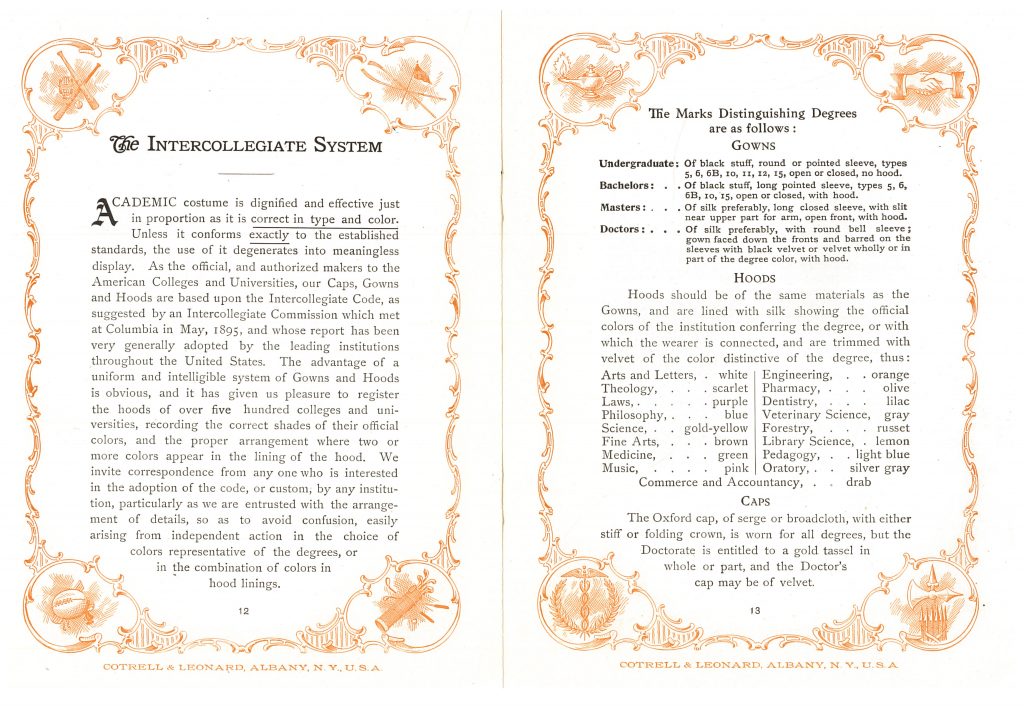Graduation season is upon us! Some students have already graduated. Others are just about to graduate. Ever wonder if academic regalia looked any different in the past? Let’s take a look at caps, gowns, and hoods in a Cotrell & Leonard trade catalog from the early twentieth century.
Cotrell & Leonard, located in Albany, New York, was established in 1832. This trade catalog, Concerning Caps, Gowns and Hoods, Bulletin No. 24, is from circa 1910. As the catalog states on the back cover, “The illustrations in this bulletin are made from photographs of actual gowns on real people, and not, as is usual in fashion plates, from wash drawings of ideal gowns on impossible people.”

Cotrell & Leonard’s gowns were custom made, which meant specific measurements were needed for each graduate. The material used for the gowns usually came in black but other colors, such as blue, purple, dark green, gray, and white were also available. All the gowns could be worn by either men or women. Each style was available as either open front or closed front. Below is an example of a graduation gown worn with an open front.

Hoods were made of the same material as gowns. Lined with silk, hoods included the official colors of the institution conferring the degree or of the institution with which the wearer was connected. The hoods were also trimmed with velvet in a color representing the degree, such as lemon for Library Science, white for Arts and Letters, or green for Medicine. It was important that correct shades of the school’s official colors were used. Just as important was that the colors were properly arranged when two or more colors were used in the lining of a hood.
The Oxford Cap was worn by all levels of graduates. The crown of the cap came in stiff or folding styles. The Doctorate Cap included a gold tassel, and that cap could be velvet.

Concerning Caps, Gowns and Hoods emphasized the importance of academic regalia following exactly the established standards or it would run the risk of becoming a “meaningless display.” The catalog went on to explain, “As the official, and authorized makers to the American Colleges and Universities, our Caps, Gowns and Hoods are based upon the Intercollegiate Code, as suggested by an Intercollegiate Commission which met at Columbia in May, 1895, and whose report has been very generally adopted by the leading institutions throughout the United States.”
Shown below are three styles of gowns manufactured by Cotrell & Leonard. The graduation gowns on the left page have closed fronts while the one on the right page has an open front.

An example of the hood for a Bachelor’s Gown is illustrated below. The catalog included a notice to students that the hood was not to be worn until commencement exercises.

Cotrell & Leonard manufactured academic regalia for all levels, including Master’s and Doctor’s degrees. The gowns for these higher levels along with the hoods are shown below. Gowns for these levels were always worn with an open front.

Each gown was packed in its own box and came with a wooden hanger. Initials of the owner were added in silk on the inside of the yoke of the gown. The company also offered the option of renting gowns and hoods.
Concerning Caps, Gowns and Hoods, Bulletin No. 24, by Cotrell & Leonard is located in the Trade Literature Collection at the National Museum of American History Library.

Be First to Comment